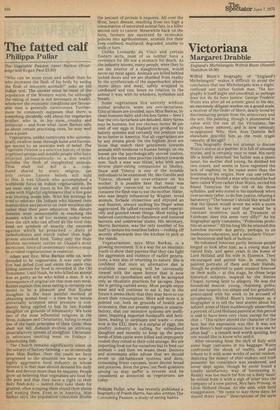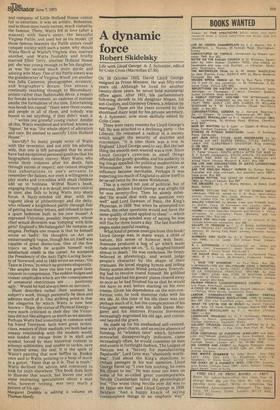Victoriana
Margaret Drabble
England's Michelangelo Wilfrid Blunt (Ha mis-h Hamilton e8.50)
Wilfrid Blunt's biography of "England's Michelangelo" makes it difficult to avoid the conclusion that our Michelangelo was a slight,
confused and rather foolish man. The biography is itself slight and anecdotal, so perhaps does not do its hero justice: George Frederic Watts was after all an artistic giant in his day, an extremely diligent worker on a grand scale, a receiver of the Order of Merit, dearly loved by discriminating people from the aristocracy and the arts. His painting, though it plummeted in value with the rest of the Victorians, has always been admired, and is now seriously. re-appraised. Why, then, does Quentin Bell elsewhere describe him as the most tragic casualty of his age?
This biography does not attempt to discuss Watts's status as a painter. It is full of amusing stories, and is certainly easy to read. His early, life is briefly sketched; his father was a piano tuner, his mother died young, he disliked hiS two sisters, and seems to have regretted the lack of euphony in his name more than the lowliness of his origins. How can one refrain from thinking foolish a man who wished he had been called Wynn rather than Watts, envied HS friend Tennyson for the roll of his three syllables, and who noted in his notebook when over seventy (after, to do him justice, refusing a baronetcy) "The honour I should like would be that the Queen would invest me with a name pleasant to my ears and that would be a constant incentive, such as Tryamain or, Fainhope; does this seem very silly?" As his biographer aptly comments, "Politeness prohibits an answer." All his long life he retained this harmless naivete: due partly, perhaps, to an inadequate education, and a peculiarly Victorian innocence and lack of humour.
He remained innocent partly because people longed to look after him: as a young man he visited Italy, and spent years in the home of Lord Holland and his wife in Florence. They encouraged and petted him: in return, he painted portraits of them and their friends, though he preferred to paint massive frescoes on their walls — at this stage, he chose large historical subjects, inspired by the Sistine Chapel, turning later to allegory. He was the household mascot: young, charming, polite. and one suspects too simple and too genuinely, preoccupied with his work to be accused of sycophancy. Wilfrid Blunt's technique as a biographer is to tell the best stories about his subject, some of them maddeningly unascribed: a portrait of Lord Holland painted at this period is said to have been very close, except for the chin — "This rather altered the character of the face, but the expression was like. It was not poor Henry's best expression, but it was one he often had" — a remark well worth quoting, but one would like to know who said it.
After returning from the idyll of Italy with some huge canvasses in his baggage, Watts confronted the shock of reality, and paid tribute to it with some works of social realism, depicting the misery of shirt-makers and Irish peasants: his conscience was awakened, and never slept again, though he never found a totally satisfactory way of harnessing it Reality was too much for him on a daily basis: he retired from it with a sigh of relief into the company of a new patron, Mrs Sara Prinsep, in Little Holland House. As she said, with littl0 exaggeration, "He came to stay three days; he stayed thirty years." Descriptions of the style
and company of Little Holland House cannot fail to entertain: it was an artistic, Bohemian, and in those days rustic retreat, much visited by the famous. There, Watts fell in love (after a manner) with Sara's sister, the beautiful Virginia Pattle, and used her as his model. (If those famous beauties the Pattle sisters could conquer society with such a name, why should Watts flinch at Watts?) Virginia, alas, married another, and Watts foolishly and briefly married Ellen Terry, another Holland House pet: she was young enough to be his daughter, as was his second much more docile and adoring wife Mary. One of the Pattie sisters was the grandmother of Virginia Woolf: yet another was Julia Cameron, photographer, eccentric, and biographer's dream. One senses a continuity reaching through to Bloomsbury: artistic rather than fashionable decor, a respect for female achievement, an easiness of manner amidst the formalities of the time. Entertaining was lavish but casual: "there were three rooms, and people in all of them, and nobody was bound to eat anything, if they didn't want it . . ." writes one grateful young visitor. Amidst all this, Watts wandered and worked: known as 'Signor,' he was "the whole object of adoration and care. He seemed to sanctify Little Holland House."
Sanctify? So many people write of Watts with like reverence, and not only his adoring wife, that one is left persuaded that he must have had exceptional personal qualities that his biographers cannot convey. Mary Watts, who wrote three volumes after his death, fails through excess of respect: one cannot imagine that exhortations to one's servants to remember the daisies, nor even a willingness to play storks and crocodiles with small children add up to holiness. Wilfrid Blunt's book, engaging though it is in detail, and more critical in tone, also fails to bring Watts into sharp focus. A fuzzy-minded old dear, with the vaguest ideas of philanthropy and the deity, who refused a knighthood partly through fear of getting too many letters, and refused to have a spare bedroom built in his .new house? A repressed Victorian, possibly impotent, whose chief sexual diversion was 'romping' with little girls? England's Michelangelo? He remains an enigma. Perhaps one reason is that he himself wrote so badly: his thoughts on Art are embarrassingly vague, though his art itself was capable of great distinction. One of the few topics on which he acquits himself with intellectual credit is the corset: he accepted the Presidency of the Anti-Tight-Lacing Society of Norwood, and in 1883 wrote an essay, 'On Taste in Dress,' in which he protests eloquently: "the ampler the form the less can good taste consent to compression. The sudden bulges and violent amplitudes which are the consequences of unnatural restrictions are . . . positively ugly," Would he had always been so succinct. Blunt describes rather than assesses his subject's work, though personally he likes and admires much of it. One striking point is that the allegories by which Watts is now best known Hope, the statue of Physical Energy were much criticised in their day: the Victorians did not like allegory as much as we assume. Perhaps Watts had something in common with his friend Tennyson: both were great technicians, masters of their medium, yet both had an uneasy relationship with the modern world, and tended to escape from it in idyll and symbol, forced by their historical context to attempt sublimities, and unable to tackle, save in limited areas, the real. It is the spirit of Watts's painting that now baffles us. Ruskin once said to Watts, pointing to a heap of muck in a gutter, "Paint that as it is. That is truth." Watts declined the advice, and continued to look for truth elsewhere. This book does little to illumine that search, but leaves one with some interesting speculations about a man who, however retiring, was very much a pattern of his age.
Margaret Drabble is editing a volume on Thomas Hardy



































 Previous page
Previous page